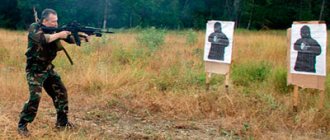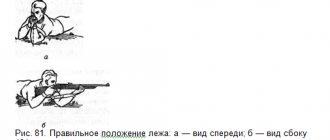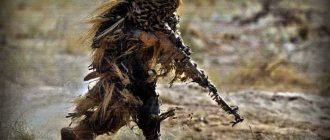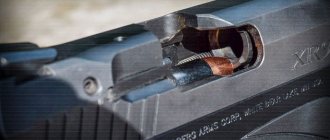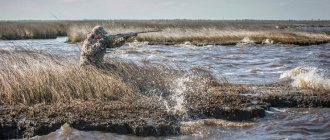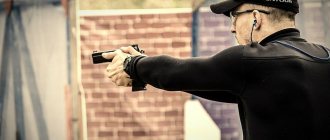Techniques for shooting small arms include: positioning, aiming, releasing the trigger and organizing breathing when shooting.
Manufacturing.
Proper preparation for shooting ensures the stability of the weapon, which affects shooting accuracy. The preparation includes taking the shooting position, loading the weapon, and loading the weapon.
To assume a prone shooting position, holding the machine gun in your right hand with the muzzle forward, take a full step forward and slightly to the right with your right foot. Lean forward and get down on your left knee. Then, leaning your left hand on the ground, consistently lower yourself onto the thigh of your left leg and the forearm of your left hand.
Lie on your left side and quickly turn onto your stomach, spreading your legs slightly to the sides with your toes facing out. The machine gun is placed with the fore-end on the palm of the left hand.
To attach a machine gun, you need to hold the machine gun with your left hand by the fore-end or the magazine, and with your right hand by the pistol grip and without losing sight of the target, rest the butt against your shoulder. Place the index finger of the right hand (first joint) on the trigger. When shooting prone, there must be a certain angle between the shooter’s body and the shooting plane. The amount of body displacement to the left from the direction of fire depends on the physique of the shooter. If the arms are short, then it is advisable to place the body at a large angle to the direction of fire, if the arms are long, at a smaller angle. Typically, the angle between the body and the direction of fire ranges from 25° to 30°
The head should be tilted slightly forward and, without straining the neck, the right cheek should be lightly pressed to the butt. In this case, the right eye should be at the level of the sight and 25–30 cm from it, or at such a distance that would allow the shooter to see the sight slot and the front sight most clearly and always uniformly. The butt plate of the butt should fit snugly in the middle of the shoulder.
The shooter finds the correct position of the body relative to the stop by slightly moving the body forward or backward until it reaches a position that is comfortable for itself. The correct position depends on the position of the body, legs, arms and head of the shooter. And the stability of the weapon, in turn, depends on the correct attachment. To check the correct position of the butt, after making the butt, raise your right hand to the side to shoulder height. If the stock is not tightly or incorrectly attached to the shoulder, it will slip down or up when you raise your arm.
Aiming –
This is a set of actions by the shooter intended to give the weapon’s bore a position in space that ensures that the bullet flies in the desired direction and to the required distance. These actions are performed using a sight and front sight.
In order to maintain uniformity of positioning and positioning throughout the shooting, the initial aiming of the weapon at the target should be done not with the hands, but by moving the body, without changing the position of the left hand. If the weapon is aimed low, then the body must be moved back. If the weapon is pointed high, the body moves forward. When the body and legs move to the right, the barrel of the weapon moves to the left, and when the body moves to the left, the barrel moves to the right.
It is useful to close your eyes and relax your muscles after you have finished roughly aiming the weapon in the direction of the target. Then, opening your eyes, look where the weapon is pointed, and, if necessary, correct the rough aiming.
To aim, you need to close your left eye, and look through the slot of the sight at the front sight with your right eye so that the front sight is strictly in the middle of the slot, and its top is level with the upper edges of the mane of the sighting bar. This is called taking an even front sight; she must be held. In order not to reduce shooting accuracy, it is not recommended to aim for a long time. If the opening of fire is delayed for some reason, it is better to stop aiming and give the eye a rest for 5-10 seconds.
Holding your breath as you exhale, moving your elbows, and if necessary, your body and legs, bring the front sight straight to the aiming point, while simultaneously selecting the idle stroke of the trigger, pressing it with the first joint of your index finger.
To release the trigger, you need to firmly hold the machine gun with your left hand by the fore-end or magazine, and with your right hand pressing the pistol grip to your shoulder, holding your breath, smoothly press the trigger until the trigger, unnoticed by the shooter, is released from the cocking position, that is, until there will be no shot.
When firing in bursts, keep the butt of the machine gun firmly pressed to the shoulder, without changing the position of the elbows and keeping the front sight taken straight in the sight slot under the selected aiming point. After each burst, quickly restore correct aiming and continue shooting. When shooting while lying down, you are allowed to rest the machine gun with its magazine on the ground.
Errors in aiming.
If the front sight is moved away from the middle of the slot, as well as above or below its edges, accurate shooting will not work. In this case, the greater the error in the position of the front sight relative to the sight slot, the greater will be the deviation of the bullets from the aiming point. In all cases, the bullets are deflected in the direction of the front sight displacement.
Selecting a sight and aiming point.
Firing from a machine gun consists of preparing to fire, firing (shot) and stopping shooting.
Getting ready to fire
includes taking the shooting position and loading the machine gun. When firing from a standing position, the machine gunner assumes a shooting position while standing, kneeling, or lying down, depending on the terrain conditions and enemy fire. While on the move, the machine gunner can fire without stopping or with a short stop. Preparation for firing is carried out at the command of the commander or independently. Guided by the general rules for performing shooting techniques and taking into account their individual characteristics, each machine gunner develops and applies the most advantageous and stable positions for shooting, achieving a uniform position of the head, body, arms and legs.
Shooting production
includes installation of the sight, setting the translator to the required type of fire, placing the gun, aiming, pulling the trigger and holding the machine gun while firing. Depending on the task and the situation, fire is carried out at the command of the commander or independently. The command to open fire usually specifies who to shoot, the target, the sight and the aiming point. When shooting at targets at ranges up to 300 m, the sight and aiming point may not be indicated.
Depending on the situation, stop shooting
may be temporary or complete. To temporarily stop firing, the command “Stop” or “Cease fire” is given. Following these commands, the machine gunner stops pressing the trigger, puts the machine on safety and, if necessary, changes the magazine. To completely stop firing, after the command “Stop” or “Cease fire,” the command “Unload” is given. At this command, the machine gunner puts the safety on the machine gun, sets the “P” sight and unloads the machine gun.
The sight and aiming point are selected by the machine gunner in such a way that when firing, the average trajectory passes through the middle of the target. When shooting at a distance of up to 300 m, fire should be carried out, as a rule, with a 3 or “P” sight, aiming at the lower edge of the target or the middle if the target is high.
When shooting at ranges exceeding 300 m, the sight is set according to the distance to the target, rounded to the nearest hundred meters. The aiming point is usually taken to be the middle of the target. If the conditions of the situation do not allow changing the sight setting depending on the distance to the target, then within the range of a direct shot, fire should be carried out with a “P” sight, aiming at the lower edge of the target.
Standards for shooting from a machine gun
To assess the shooter’s training, it is necessary to assess his compliance with the established standards. The following describes the existing requirements in this area. The most applied standards are described.
Getting ready to fire
This is about how quickly a soldier can prepare for different positions. There are several varieties of the standard under consideration. It must be confirmed for shooting standing, behind cover, prone or kneeling.
Execution occurs as follows. The shooter is located ten meters from the firing position. The machine is in the “belt” position. In this case, the prepared magazine with cartridges is in the bag.
The inspector gives the person being inspected some introductory information: indicates where the firing position is located, talks about the position from which it will be necessary to fire. The soldier must move to the shooting position, take a suitable position, load the machine gun and report to the commander that he is ready.
This exercise needs to be done within a few seconds. The standards are considered separately for each position in which fire is opened. For a machine, the standards are the same in different cases. If you need to shoot “standing”, “prone” or “kneeling”, then the readiness time is 7, 8 or 10 seconds. The first number corresponds to the rating “excellent”, the second - “good”, the third - “satisfactory”.
The video shows techniques that are used when shooting from a Kalashnikov assault rifle
Unloading a weapon
In this case, the starting position is when the soldier is holding a loaded machine gun in his hands. At the command of the manager, he must begin to discharge it. His task includes the following actions. The soldier takes out the magazine and removes the cartridges from it, then puts them in his bag. After this, he stands at a distance of 10 m from the place from which the fire will be fired.
The exercise is carried out for speed and accuracy of execution. If it took no more than 16 seconds, this corresponds to an “excellent” rating. If 17 is “good”, 20 is “satisfactory”.
Incomplete disassembly of weapons
In order to keep the machine in order, it is necessary to disassemble it. It is used to inspect, lubricate or repair weapons. There is complete and partial disassembly and reassembly. In most cases, the first option is used. The second is usually necessary when the weapon is heavily soiled and thorough cleaning is required.
In order to evaluate the actions of the trainee, it is necessary that he complete the following. He stands in front of a clean table. The machine gun lies in front of him. The goal is to complete partial disassembly within a specified time. At the command of the manager, he strives to do it in the minimum time.
To get an excellent mark, it will be enough if he completes the disassembly in 13 seconds. 14 means “good”, 17 means “satisfactory”.
Incomplete weapon assembly
The starting point is this. That in front of the soldier there is a disassembled machine gun, the parts are laid out in the order they were removed. His task is to complete the assembly in the minimum amount of time. In order to receive an “excellent” rating, he must do this in no longer than 23 seconds. 25 is enough for a “good” rating, and 30 for a “satisfactory” rating.
Shop equipment
Before the test begins, the student stands in front of the table. In front of him are a scattering of cartridges. Next to them is an empty store. The task is to fill it completely with cartridges.
After the inspector's signal, the person begins work. He must do it in the shortest possible time. If it takes no more than 30 seconds, he will receive an “excellent” rating. Having loaded the magazine for 35, it will earn “Good”, and at 40 – “Satisfactory”.
Additional Tips
As you master your air rifle shooting technique, you may want to consider the following additional tips.
For shooting
Professionals recommend buying several types of different bullets to choose the most suitable ones in practice. For example, bullets of increased lightness fly well, but the accuracy of hits is greatly reduced, especially in windy weather.
The sight and front sight must be securely attached to the barrel of the weapon. They must be free of chips, dents, and bends. If these important parts are damaged, you cannot shoot; the defects must be repaired immediately.
The design of the rifle must be strong, monolithic, without distortions, all fasteners on the butt must be firmly attached. Any, even the slightest deviations can worsen the quality of shooting.
Making a Shot
After the shot is fired, a certain period of time of several seconds is waited for the bullet to exit the barrel. Compared to a short pistol barrel, a rifle barrel is many times longer, and it takes more time.
Recoil when firing should be minimized, if possible, by pressing correctly against the shoulder. It is necessary to calculate the possible trajectories of ricochets in the event of a penetration of the target or a miss. When firing shots, it is advisable to use headphones to protect against noise and safety glasses from random bullet ricochets.
At close range, pneumatic bullets can not only injure, but also kill, so compliance with all safety rules is mandatory.
Weapon care
The rifle must always be in a clean condition:
- After each shooting it must be cleaned of lead and oil.
- You cannot disassemble a loaded weapon.
- The rifle should always be stored unloaded - it should only be loaded immediately before shooting.
- Professionals recommend always putting the safety on the weapon.
- Weapons must be stored out of reach, especially from children, to avoid accidents. The ideal option for this is a safe.
Anyone can learn to shoot accurately with an air rifle. To do this, a beginner needs to show diligence, take regular shooting lessons, developing technique in all existing shooting positions. And all the listed rules, techniques and tips will speed up your learning.
Shooting techniques while moving
Shooting while moving is possible in various situations. This can be done not only while walking or running, but also when performing other types of movements. Sometimes it becomes necessary to perform movements while holding the enemy at gunpoint. This can be done this way:
- Standing on your right knee, place your left foot forward. In this case, the thigh of the left leg should be located horizontally. In this position, the fighter can shoot accurately from the knee.
- To move, you need to move your front leg forward a little. And then move the back one. This movement is slow. But it allows you to carefully observe your surroundings and take careful aim.
Standing on one knee, you can somersault over your head forward, pressing the machine gun to your chest while moving. By making this movement quickly, the fighter remains in complete control of the situation.
With small movements, it is possible to use more complex tactics. For example, in certain circumstances, you can resort to moving backwards while maintaining control of the situation behind you.
To better aim while walking, experienced fighters recommend taking steps with your toes turned outward. In this case, the position during walking becomes more stable than when the foot is placed in the usual way. Another way to walk in a special way is to place your feet in one line when walking.
Techniques and rules of shooting from a machine gun
It is possible to use a weapon for firing from any selected position and place from where you can clearly see the target. When looking for a suitable location, you need to find one that allows you to have a good overview and have cover from enemy fire. It is important that this place has the opportunity to perform shooting techniques.
Usually the following positions are chosen: in a trench, trench, ditch, behind a stone or in other similar places. It is not recommended to take positions near objects that stand out. If you settle on the crest of a hill, the shooter will be at a disadvantage.
In order for a soldier to take a place to fire, you need to receive a command that sounds something like this: “The machine gunner should take such and such a place to fire, for battle.”
After this, the fighter begins to execute the command. He must act taking into account the characteristics of the terrain. Now you need to move to the starting position and get ready to fire.
Movement can be done by crawling, running, or rapid walking. Before this, to ensure movement, the machine must be set to safety. If the soldier chooses to move by crawling, he must hold the weapon by the belt near the front swivel. You can also hold it by the fore-end while moving.
Shooting techniques on the move
Sometimes, in order to complete the mission assigned by the commander, it is necessary to fire while moving. In this case, you can shoot while walking or running without stopping. Sometimes, in order to aim more accurately, a soldier opens fire while stopping.
At the same time, he throws the belt over his shoulder. This is necessary in order to make it easier to hold the machine. With his right hand he clasps the neck of the butt, and with his left he holds the weapon by the fore-end or magazine.
If you need to aim more accurately, you need to raise the weapon to eye level. After this, aiming is carried out and shooting is carried out.
To perform offhand shooting, you need to do the following:
- You need to stop and put your left leg forward.
- At this moment, the butt must be firmly rested on the shoulder.
- When aiming with your right foot, do not place your left foot in front of you.
- Perform one or two short bursts. After they are completed, they lower the weapon down and continue moving.
You can shoot without stopping. However, in most cases, aiming is less accurate. At the same time, while moving, they raise the machine gun and shoot. After this, it is lowered and movement continues.
Safety precautions
When starting to learn to shoot with an air rifle, it is important to study and be sure to follow the safety rules, which include the following main points:
- the rifle is loaded exclusively at the firing line;
- Loaded weapons must never be left unattended;
- a weapon with the hammer cocked and loaded cannot be transferred to another person;
- any pneumatic gun should be handled as if it were loaded - carefully and carefully;
- the fuse must always be in good working order; if it breaks, stop shooting and repair the damage;
- It is allowed to direct the muzzle of the rifle only towards the target, and if it is necessary to move the weapon, it is raised with the barrel up;
- leaning on the barrel, barrel with a palm, hand or other part of the body is prohibited;
- the use of bullets must be strictly for the intended purpose of the pneumatic model;
- only when fully ready to fire does the finger move to the trigger;
- Safety glasses are required when shooting at close range (less than 10 meters).
It is prohibited to approach a weapon while intoxicated or in an unhealthy state, or with hand injuries (contracture).
